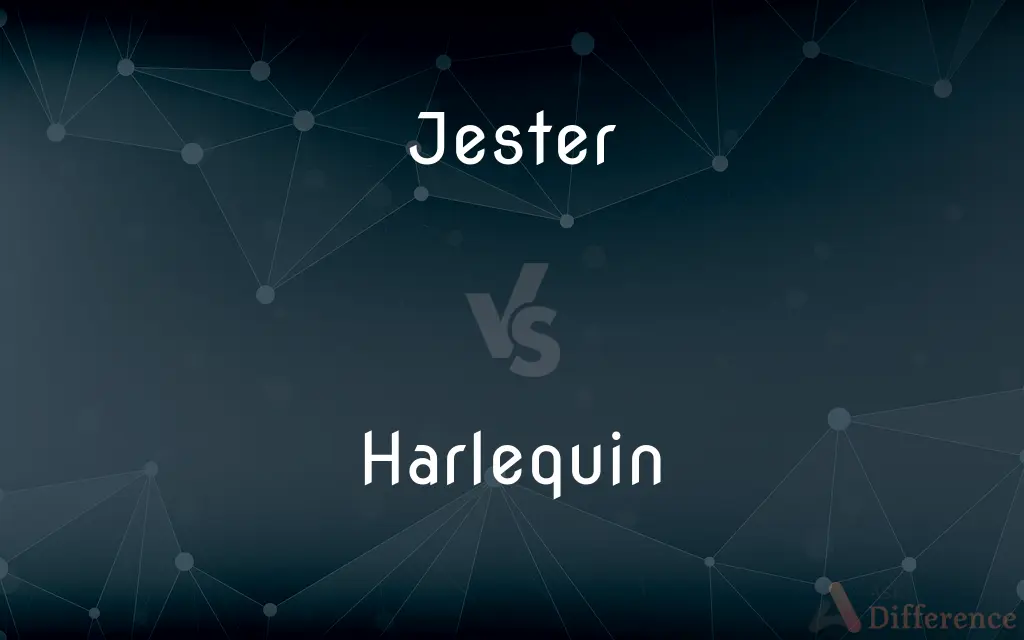Jester vs. Harlequin — What's the Difference?
By Tayyaba Rehman — Updated on October 20, 2023
A jester is a court entertainer historically known for jests and comedy. A harlequin is a theatrical character in pantomime, recognized by a distinct diamond-patterned costume. Both played roles in entertaining, but in different contexts.

Difference Between Jester and Harlequin
Table of Contents
ADVERTISEMENT
Key Differences
The jester, often adorned with a colorful costume and a hat with bells, historically played the role of an entertainer in the royal courts of Europe. Their primary function was to provide comedy and entertainment for monarchs and courtiers. Jesters are often associated with the Middle Ages, acting as fool-like characters that used wit, jests, and sometimes music to entertain. Harlequin, on the other hand, originates from Italian commedia dell'arte and later became central to European pantomime. The character is distinctly recognized by his brightly colored, diamond-patterned costume.
While jesters utilized verbal wit, satire, and sometimes physical comedy to amuse their audiences, harlequins were more physically oriented performers. Harlequins often engaged in mime or slapstick routines, telling stories through exaggerated actions rather than words. The nature of their performances was less personal and direct compared to jesters who directly interacted and sometimes even teased their noble audience.
The symbolism associated with both is different. Jesters are often seen as figures that use humor to speak truths, sometimes being the only ones who could openly mock or critique rulers without facing repercussions. Harlequins represent more of a love-struck, nimble character in most theatrical presentations, especially in the pantomime context where Harlequin seeks the love of his counterpart, Columbine.
In terms of cultural evolution, the role of the jester waned as royal courts became less prominent. The harlequin, however, evolved and found a place in broader European theater traditions, particularly in the pantomimes of England. Today, while both figures are less prevalent, they still represent distinct periods and forms of entertainment in European history.
Comparison Chart
Historical Origin
European royal courts
Italian commedia dell'arte
ADVERTISEMENT
Performance Style
Verbal wit, jests, music
Mime, slapstick, physical comedy
Recognizable Features
Colorful costume, hat with bells
Diamond-patterned, colorful costume
Symbolism
Truth-teller in the guise of comedy
Love-struck, nimble character
Cultural Evolution
Declined with the waning of royal courts
Transitioned to European pantomime
Compare with Definitions
Jester
An individual who jests or jokes.
He was the jester of the group, always making everyone laugh.
Harlequin
A mime performer in pantomime plays.
With no words, the harlequin expressed a world of emotions.
Jester
A historical entertainer in royal courts known for comedy.
The jester lightened the mood of the court with his playful antics.
Harlequin
Anything with a bright, varied color pattern.
The harlequin fabric was a mix of vibrant colors.
Jester
A character adorned with a bell-adorned hat.
Kids were delighted to see the jester's colorful outfit at the festival.
Harlequin
A representation of a mischievous, love-struck individual.
The harlequin chased his love, Columbine, across the stage.
Jester
A person who uses humor to highlight truths.
The jester cleverly pointed out the king's folly through a jest.
Harlequin
A theatrical character recognized by a diamond-patterned costume.
The harlequin's acrobatics stole the show.
Jester
A professional fool or clown.
The jester's performance was the highlight of the medieval fair.
Harlequin
A character originating from Italian commedia dell'arte.
The history of theater is incomplete without mentioning the iconic harlequin.
Jester
A jester, court jester, or fool, was historically an entertainer during the medieval and Renaissance eras who was a member of the household of a nobleman or a monarch employed to entertain guests. Jesters were also itinerant performers who entertained common folk at fairs and town markets.
Harlequin
Harlequin (; Italian: Arlecchino [arlekˈkiːno]) is the best-known of the zanni or comic servant characters from the Italian commedia dell'arte. The role is traditionally believed to have been introduced by Zan Ganassa in the late 16th century, was definitively popularized by the Italian actor Tristano Martinelli in Paris in 1584–1585, and became a stock character after Martinelli's death in 1630.
Jester
A professional joker or ‘fool’ at a medieval court, typically wearing a cap with bells on it and carrying a mock sceptre.
Harlequin
Harlequin A conventional buffoon of the commedia dell'arte, traditionally presented in a mask and parti-colored tights.
Jester
One given to jesting.
Harlequin
A clown; a buffoon.
Jester
A fool or buffoon at medieval courts.
Harlequin
Having a pattern of brightly colored diamond shapes.
Jester
One who jests, jokes or teases.
Harlequin
A pantomime fool, typically dressed in colorful checkered clothes.
Jester
A person in colourful garb and fool's cap who amused a medieval and early modern royal or noble court.
Harlequin
A greenish-chartreuse color.
Jester
Any of various nymphalid butterflies of the Southeast Asian genus Symbrenthia.
Harlequin
(informal) A harlequin duck.
Jester
A buffoon; a merry-andrew; a court fool.
This . . . was Yorick's skull, the king's jester.
Dressed in the motley garb that jesters wear.
Harlequin
(entomology) Any of various riodinid butterflies of the genera Taxila and Praetaxila.
Jester
A person addicted to jesting, or to indulgence in light and amusing talk.
He ambled up and downWith shallow jesters.
Harlequin
Brightly colored, especially in a pattern like that of a harlequin clown's clothes.
Jester
A professional clown employed to entertain a king or nobleman in the middle ages
Harlequin
Of a greenish-chartreuse color.
Harlequin
(transitive) To remove or conjure away, as if by a harlequin's trick.
Harlequin
(intransitive) To make sport by playing ludicrous tricks.
Harlequin
A buffoon, dressed in party-colored clothes, who plays tricks, often without speaking, to divert the bystanders or an audience; a merry-andrew; originally, a droll rogue of Italian comedy.
As dumb harlequin is exhibited in our theaters.
Harlequin
To play the droll; to make sport by playing ludicrous tricks.
Harlequin
To remove or conjure away, as by a harlequin's trick.
And kitten, if the humor hitHas harlequined away the fit.
Harlequin
A clown or buffoon (after the Harlequin character in the commedia dell'arte)
Harlequin
Variegate with spots or marks;
His face was harlequined with patches
Common Curiosities
Were jesters always humorous?
Mostly, but jesters could also use humor to subtly critique or convey truths to rulers.
Did jesters perform outside of courts?
Primarily associated with courts, some jesters did perform publicly, especially as the role evolved.
Is a harlequin a type of jester?
No, while both entertain, a harlequin is a specific theatrical character, distinct from jesters.
What is the primary role of a jester?
A jester's primary role was to entertain and amuse in royal courts using comedy.
Were jesters exclusive to Europe?
While prominent in European history, similar court entertainers existed in other cultures.
How did the harlequin character evolve?
Originating from Italian commedia dell'arte, harlequins transitioned into European pantomime.
What distinguishes a harlequin's costume?
A harlequin is known for a brightly colored, diamond-patterned costume.
Were jesters always well-received in courts?
While many were appreciated, jesters could face disdain if their jests were too cutting or inappropriate.
Why is the harlequin often portrayed in silent performances?
The harlequin's roots in mime and pantomime focus on physical comedy over verbal.
Is the harlequin character always male?
Traditionally, yes, but modern interpretations can vary.
Do jesters and harlequins share a similar history?
Both are rooted in European entertainment but represent different contexts and eras.
Was there any symbolic meaning to a jester's hat?
The jester's hat, often with bells, symbolized the dual nature of comedy and sadness.
What's the relationship between harlequin and Columbine in pantomimes?
Harlequin often plays a love-struck character seeking the affections of Columbine.
Are harlequins still prominent in modern theater?
While less common, the harlequin's influence can still be seen in certain theatrical traditions.
Is the term "jester" used in modern times?
Less so for the historical role, but it can still denote someone jesting or joking.
Share Your Discovery

Previous Comparison
Prudent vs. Husband
Next Comparison
Contend vs. ContentAuthor Spotlight
Written by
Tayyaba RehmanTayyaba Rehman is a distinguished writer, currently serving as a primary contributor to askdifference.com. As a researcher in semantics and etymology, Tayyaba's passion for the complexity of languages and their distinctions has found a perfect home on the platform. Tayyaba delves into the intricacies of language, distinguishing between commonly confused words and phrases, thereby providing clarity for readers worldwide.















































